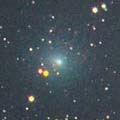
|
Already bright as 10.3 mag (June 12, Juan Jose Gonzalez). It is brightening rapidly now, and will reach to 8 mag in July. However, it moves southwards very fast in August. It is only observable until mid August in the Northern Hemisphere. On the other hand, it keeps low and hard to observe until mid July in the Southern Hemisphere.
Date(TT) R.A. (2000) Decl. Delta r Elong. m1 Best Time(A, h)
June 16 22 54.16 50 39.6 1.152 1.374 78 11.0 5:19 (180, 4)
June 23 22 24.56 57 11.8 0.949 1.302 82 10.3 4:23 (180, -2)
|
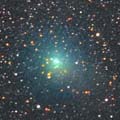
|
It passed near by the earth in mid April, and reached to 7.6 mag (Apr. 18, Juan Jose Gonzalez). It locates high in the evening sky, and it is observable in good condition. But it already faded won to 11.3 mag (May 26, Seiichi Yoshida). It keeps observable in good condition in the Northern Hemisphere until the comet has gone. It will be visible visually until July.
Date(TT) R.A. (2000) Decl. Delta r Elong. m1 Best Time(A, h)
June 16 13 29.98 62 55.8 1.492 1.672 81 11.8 19:52 (180, -8)
June 23 13 20.61 61 53.2 1.655 1.750 77 12.2 19:15 (180, -7)
|
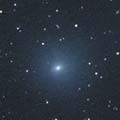
|
It passed near by the earth in early April, and reached to 8.7 mag (Apr. 10, Werner hasubick). Then it faded down to 11.8 mag on May 26 (Seiichi Yoshida), and became too low to observe in the evening. Now it is not observable. It will appear in the morning sky again at 15 mag in August.
Date(TT) R.A. (2000) Decl. Delta r Elong. m1 Best Time(A, h)
June 16 7 17.76 23 52.3 2.202 1.332 23 12.1 18:25 (120, 1)
June 23 7 15.87 24 11.4 2.308 1.363 16 12.4 18:26 (116, -5)
|
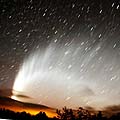
|
Excellent great comet, few times in a lifetime, for southern people. It reached to -5.5 mag on Jan. 14 and 15, brighter than Venus, and visible even in daytime. Then it appeared in the evening sky in the Southern Hemisphere and many people enjoyed a fantastic view of a beautiful great comet, a enormous curving tail with so many striae over 50 degrees. Now it is observable both in the evening and morning. It has already faded down to 12.3 mag (June 9, Masayuki Suzuki). In the Southern Hemisphere, It keeps observable almost all night until the comet has gone. It will never be observable again in the Northern Hemisphere.
Date(TT) R.A. (2000) Decl. Delta r Elong. m1 Best Time(A, h)
June 16 10 48.58 -78 19.1 2.492 3.002 110 12.1 18:25 ( 5, 46)
June 23 11 18.53 -76 5.1 2.599 3.097 109 12.4 18:26 ( 6, 48)
|
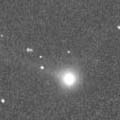
|
It had been observed while brightening rapidly until the perihelion passage on Apr. 19, although it located extremely low in the evening sky. It reached to 6.7 mag on Apr. 17 (Juan Jose Gonzalez). In the Southern Hemisphere, it appeared in the morning sky at 7.8 mag in early May (May 9, Alexandre Amorim). Now it is 8.6 mag (May 11, Con Stoitsis). Then it is fading rapidly. Now it is 10.9 mag (May 27, Ken-ichi Kadota). It became observable also in the Northern Hemisphere again. But it locates only 20 degree high at most, and it will be fading rapidly.
Date(TT) R.A. (2000) Decl. Delta r Elong. m1 Best Time(A, h)
June 16 23 25.10 -26 25.6 0.528 1.241 102 12.4 5:35 (202, 81)
June 23 22 54.71 -29 29.8 0.541 1.343 115 13.0 4:53 (180, 84)
|
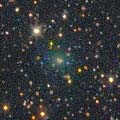
|
It became brighter than expected, and reached to 13.2 mag (May 12, Carlos Labordena). However, it is already not observable. In the Southen Hemisphere, it will be observable again at 15 mag in November. But in the Northern Hemisphere, it will never observable again.
Date(TT) R.A. (2000) Decl. Delta r Elong. m1 Best Time(A, h)
June 16 7 40.84 25 57.2 2.690 1.861 28 13.2 18:25 (125, 3)
June 23 7 58.63 23 48.3 2.700 1.841 26 13.1 18:26 (122, 3)
|
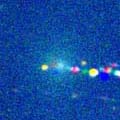
|
New comet discovered in the Southern Hemisphere. In the Southern Hemisphere, it is observable in the evening sky until early August while the comet is fading gradually down to 16 mag. In the Northern Hemisphere, it is not observable until when the comet becomes fainter than 18 mag. It was not discovered in last autumn when the comet located in the good condition, so it may fade out rapidly after this.
Date(TT) R.A. (2000) Decl. Delta r Elong. m1 Best Time(A, h)
June 16 7 31.92 -13 45.9 1.828 1.352 46 13.6 18:25 ( 91, 26)
June 23 8 3.20 -13 4.2 1.900 1.411 46 13.9 18:26 ( 92, 27)
|

|
It had been bright as 12-13 mag and visible visually almost always from 2006 July to 2007 April. However, now it is not observable. It will appear in the morning sky again in late July.
Date(TT) R.A. (2000) Decl. Delta r Elong. m1 Best Time(A, h)
June 16 5 12.85 29 30.6 6.924 5.919 8 14.0 5:35 (245,-17)
June 23 5 19.20 29 35.4 6.912 5.922 11 14.0 5:37 (243,-13)
|
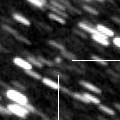
|
Now it is 15.6 mag (May 27, Ken-ichi Kadota), brightening as expected. It will reach to 14.5 mag in 2007 summer. However, it moves in the southen sky. In the Northern Hemisphere, it becomes unobservable in July.
Date(TT) R.A. (2000) Decl. Delta r Elong. m1 Best Time(A, h)
June 16 20 33.14 -38 50.5 2.728 3.561 139 14.7 2:59 ( 0, 86)
June 23 20 22.62 -41 41.5 2.644 3.532 146 14.6 2:21 ( 0, 83)
|
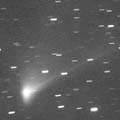
|
After the perihelion passage on Apr. 4, it appeared in the morning sky and it was so bright as 5.5 mag (Apr. 10, Michael Jager and Gerald Rhemann). Then it is fading rapidly. But it is bright as 12.8 mag still now (May 26, Seiichi Yoshida). Now the location is very good, so it will be bright for some more time.
Date(TT) R.A. (2000) Decl. Delta r Elong. m1 Best Time(A, h)
June 16 18 16.00 2 57.3 0.702 1.668 151 14.6 0:43 (180, 52)
June 23 17 44.17 -1 3.8 0.791 1.772 157 15.2 23:36 (180, 56)
|
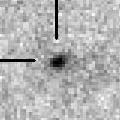
|
It appeared in the morning sky. It is bright as 14.9 mag (May 25, Ken-ichi Kadota). It will be getting higher gradually after this, and it will keep bright as 15 mag and observable in good condition for a long time until autumn.
Date(TT) R.A. (2000) Decl. Delta r Elong. m1 Best Time(A, h)
June 16 1 37.30 21 14.6 2.494 2.080 54 14.6 5:35 (218, 24)
June 23 1 50.31 23 18.6 2.445 2.090 57 14.6 5:37 (213, 24)
|
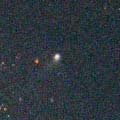
|
Now it is bright and visible visually at 14.1 mag (May 26, Seiichi Yoshida). It will be observable at 14.5 mag at high location from spring to summer both in 2007 and 2008.
Date(TT) R.A. (2000) Decl. Delta r Elong. m1 Best Time(A, h)
June 16 18 0.78 -4 8.2 4.840 5.804 159 14.7 0:27 (180, 59)
June 23 17 52.56 -3 35.8 4.826 5.791 159 14.6 23:46 (180, 59)
|

|
It will reach to 11 mag in 2008 spring. It will keep bright for a long time, however, it keeps moving in the southern sky for a while after this. In the Southern Hemisphere, now it is low temporarily. But it will be high after July, then it keeps observable in good condition until 2008 summer. In the Northern Hemisphere, it will appear at 13 mag in November in a short time, but very low and hard to observe. However, it will be visible visually at 11 mag in the evening sky from March to June in 2008. Then it becomes unobservable again. But it will appear in the morning sky again at 13 mag at the end of 2008, then it keeps bright and observable for a while.
Date(TT) R.A. (2000) Decl. Delta r Elong. m1 Best Time(A, h)
June 16 6 16.06 -26 3.5 5.237 4.655 50 15.1 18:25 ( 70, 17)
June 23 6 24.64 -26 1.7 5.197 4.605 49 15.0 18:26 ( 67, 13)
|
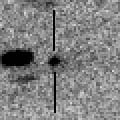
|
New periodic comet. Now it is bright as 15.2 mag (June 4, Ken-ichi Kadota). It will be observable in very good condition at 14 mag from summer to autumn. It may be visible visually. However, it was not discovered at the previous apparition in 1999. So it may be bright temporarily in outburst.
Date(TT) R.A. (2000) Decl. Delta r Elong. m1 Best Time(A, h)
June 16 23 31.55 -3 32.1 2.049 2.323 92 15.2 5:35 (190, 58)
June 23 23 40.45 -3 11.9 1.962 2.315 96 15.1 5:37 (180, 58)
|
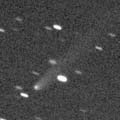
|
It has been visible at 13.5 mag for a long time since 2005 autumn until 2006 spring. It was still bright and visible visually as 14.2 mag in winter (Dec. 22, Seiichi Yoshida). However, it has already faded down to 16.4 mag (May 26, Ken-ichi Kadota). Fine tail is visible on CCD images. It will be getting lower gradually after June, and will be too low to observe in September.
Date(TT) R.A. (2000) Decl. Delta r Elong. m1 Best Time(A, h)
June 16 12 37.41 19 1.4 5.915 6.104 95 15.3 19:00 (180, 36)
June 23 12 38.36 18 14.1 6.042 6.130 90 15.4 18:34 (180, 37)
|
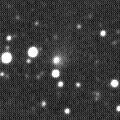
|
It kept 12 mag for over half a year since last June. It was still bright as 12.6 mag on Mar. 9 (Edwin van Dijk). But it has already started fading, and will be already too faint to see visually. However, the fading is slow. The comet will be fainter than 18 mag in 2008. In the Northern Hemisphere, it keeps observable until that time.
Date(TT) R.A. (2000) Decl. Delta r Elong. m1 Best Time(A, h)
June 16 4 41.50 66 8.8 3.785 3.130 43 15.3 5:35 (207,-29)
June 23 4 54.94 65 41.3 3.844 3.188 43 15.5 5:37 (207,-27)
|
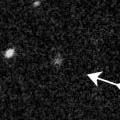
|
It will reach to 10.5 mag and will be observable in good condition in 2008 autumn. Now it is 16.0 mag (May 22, Ken-ichi Kadota), brightening as expected. It keeps observable in good condition for a long time while the comet is getting brighter slowly.
Date(TT) R.A. (2000) Decl. Delta r Elong. m1 Best Time(A, h)
June 16 22 8.84 -10 14.8 4.697 5.192 113 15.8 4:34 (180, 65)
June 23 22 8.33 -9 55.3 4.546 5.137 120 15.7 4:06 (180, 65)
|
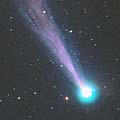
|
It reached up to 4 mag in 2006 autumn. But it had faded down to 10.5 mag on Jan. 11 (Carlos Labordena). It had been unobservable for a long time since that, but now it is appearing at dawn again. Now it is 16.8 mag (May 27, Ken-ichi Kadota), fading rather rapidly. After this, it keeps observable until it becomes fainter than 18 mag in autumn.
Date(TT) R.A. (2000) Decl. Delta r Elong. m1 Best Time(A, h)
June 16 23 1.89 -16 13.9 3.482 3.854 103 16.0 5:27 (180, 71)
June 23 22 59.03 -17 30.0 3.443 3.932 111 16.1 4:57 (180, 72)
|
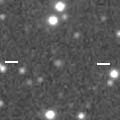
|
Now it is 17.3 mag (June 2, Ken-ichi Kadota). It will reach to 12 mag in 2008 summer. In the Northern Hemisphere, it keeps observable almost all time until that while the comet is brightening gradually. However, it goes to the southern sky and will never be observable again in the Northern Hemisphere after that.
Date(TT) R.A. (2000) Decl. Delta r Elong. m1 Best Time(A, h)
June 16 17 19.71 35 20.8 5.057 5.651 121 16.5 23:41 (180, 20)
June 23 17 13.01 34 47.3 5.014 5.599 120 16.5 23:07 (180, 20)
|
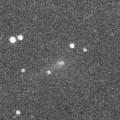
|
Originally considered as a peculiar asteroid, but revealed to be a comet. In the Southern Hemisphere, it became observable in late April. It approached to Sun down to 0.6 A.U. in late April, then it passed very near by Earth in May. It moved eastwards extremely fast, and it became observable in the evening sky on May 23 also in the Northeren Hemisphere. It keeps observable in the evening sky. It was predicted to fade out rapidly. However, it was 12.8 mag on May 24 (Alan Hale), 13.5-14.0 mag on June 6 (Michael Jager and Gerald Rhemann), so it is still bright. It is predicted to be fainter than 18 mag in late June. But it may be brighter than this ephemeris for a while.
Date(TT) R.A. (2000) Decl. Delta r Elong. m1 Best Time(A, h)
June 16 10 32.86 20 43.2 1.058 1.162 68 16.6 18:25 (156, 31)
June 23 10 46.51 20 16.9 1.313 1.273 64 17.3 18:26 (152, 30)
|
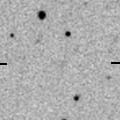
|
Now it is 18.2 mag (May 4, Ken-ichi Kadota). It will approach down to 0.4 A.U. to the sun on Oct. 28, and it is expected to reach to 6 mag. However, the condition in the Northern Hemisphere is very hard. It will be getting lower in the evening sky after this. The altitude becomes lower than 20 degree in early July, and lower than 10 degree in late July. The comet is still faint as 15.5 mag at that time. After conjunction with the sun, the comet will be brighter than 11 mag in late September, and will be 8 mag in mid October. But it locates extremely low, slightly over the horizon in the morning sky. It goes to the southern sky in late October, then it will never be observable again. In the Southern Hemisphere, it becomes unobservable in July. But it will appear in the evening sky at 7 mag in early November. Then it keeps observable while fading gradually, although it will not locate very high.
Date(TT) R.A. (2000) Decl. Delta r Elong. m1 Best Time(A, h)
June 16 10 3.59 29 1.6 2.909 2.550 59 16.9 18:25 (153, 20)
June 23 10 4.65 28 59.7 2.915 2.451 53 16.7 18:26 (147, 17)
|
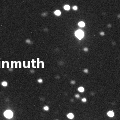
|
Observed on June 12 by Joao Gregorio, but not officially announced yet. It should have already brightened up to 17 mag. It will be observable at 16.5 mag in summer and autumn in 2007, and observable at 17 mag in summer and autumn in 2008.
Date(TT) R.A. (2000) Decl. Delta r Elong. m1 Best Time(A, h)
June 16 17 50.25 -26 37.5 1.753 2.766 175 16.8 0:16 (180, 82)
June 23 17 43.94 -26 22.2 1.724 2.737 174 16.7 23:38 (180, 81)
|
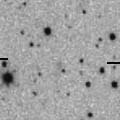
|
Now it is 17.2 mag (May 22, Ken-ichi Kadota). It will be observable at 16.5-17 mag in good condition in summer.
Date(TT) R.A. (2000) Decl. Delta r Elong. m1 Best Time(A, h)
June 16 20 45.04 13 11.0 5.266 5.855 121 16.8 3:10 (180, 42)
June 23 20 39.37 14 3.4 5.188 5.853 126 16.7 2:37 (180, 41)
|

|
Now it is 16.7 mag (May 27, Ken-ichi Kadota). It is outside of Jupiter's orbit. So it keeps 17 mag for a long time until 2007 summer. It keeps locating high and observable in good condition for a long time after this because it moves in the northern sky.
Date(TT) R.A. (2000) Decl. Delta r Elong. m1 Best Time(A, h)
June 16 13 42.90 35 37.7 7.269 7.502 99 16.9 20:05 (180, 19)
June 23 13 41.00 34 42.1 7.370 7.521 94 17.0 19:36 (180, 20)
|

|
Now it is 18.1 mag (Apr. 14, Maciej Reszelski). It is observable at 17.5-18 mag until autumn. It was discovered at 18 mag in 2006. It is a distant periodic comet, and it keeps observable at 18 mag for 4 years until 2009.
Date(TT) R.A. (2000) Decl. Delta r Elong. m1 Best Time(A, h)
June 16 19 12.02 -11 24.9 3.245 4.183 154 17.4 1:38 (180, 66)
June 23 19 8.32 -11 46.5 3.206 4.179 160 17.3 1:07 (180, 67)
|

|
First return of a new periodic comet discovered in 1998 at 14 mag. It was expected to reach to 15.5 mag in 2007 summer and autumn. But it has been not recovered yet. It was fainter than 22.5 mag in 2006 September (Carl Hergenrother). It must be much fainter than expected, by 4-5 mag or more. It can reach to 20 mag at best actually.
Date(TT) R.A. (2000) Decl. Delta r Elong. m1 Best Time(A, h)
June 16 23 59.19 -4 40.3 2.714 2.838 86 21.5 5:35 (203, 58)
June 23 0 5.59 -3 48.4 2.606 2.819 91 21.4 5:37 (192, 58)
|
|
![]()
 P/2007 H1 ( McNaught )
P/2007 H1 ( McNaught ) C/2003 WT42 ( LINEAR )
C/2003 WT42 ( LINEAR ) C/2006 L2 ( McNaught )
C/2006 L2 ( McNaught ) C/2006 OF2 ( Broughton )
C/2006 OF2 ( Broughton ) C/2006 M4 ( SWAN )
C/2006 M4 ( SWAN ) C/2007 G1 ( LINEAR )
C/2007 G1 ( LINEAR ) C/2006 WD4 ( Lemmon )
C/2006 WD4 ( Lemmon ) C/2007 F1 ( LONEOS )
C/2007 F1 ( LONEOS ) 44P/Reinmuth 2
44P/Reinmuth 2 C/2005 S4 ( McNaught )
C/2005 S4 ( McNaught ) C/2002 VQ94 ( LINEAR )
C/2002 VQ94 ( LINEAR ) P/2006 F1 ( Kowalski )
P/2006 F1 ( Kowalski ) P/1998 S1 ( LINEAR-Mueller )
P/1998 S1 ( LINEAR-Mueller )![]()






















